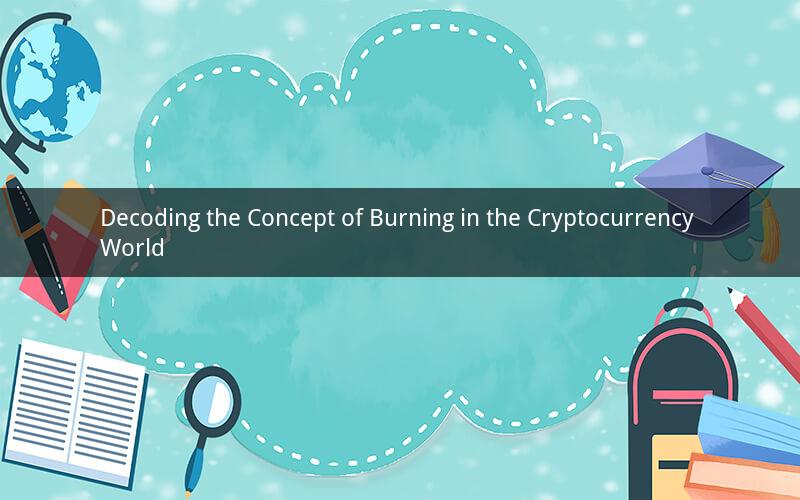
In the vast landscape of cryptocurrencies, the term "burning" has gained significant attention. It refers to a process where a certain amount of a cryptocurrency is permanently removed from circulation, thereby reducing the total supply. This strategy is often used to increase the scarcity and value of the token. In this article, we will explore what burning means in the crypto world, its implications, and its impact on the market.
1. What is burning in the crypto world?
Burning, in the context of cryptocurrencies, is the act of destroying a specific amount of tokens to reduce the overall supply. This process is usually carried out by the developers or a governing body responsible for the token. Once the tokens are burned, they are rendered unusable and cannot be retrieved, thereby decreasing the total supply of the currency.
2. Why do cryptocurrencies burn tokens?
There are several reasons why cryptocurrencies choose to burn tokens:
a. Increase scarcity: By reducing the total supply of a token, burning increases its scarcity, which, in turn, can lead to an increase in its value.
b. Prevent inflation: Burning tokens can help prevent inflation by reducing the number of coins in circulation.
c. Reward holders: Burning tokens can be used as a reward for long-term holders, who may benefit from the increased value of their holdings.
d. Manipulate market sentiment: Burning tokens can create a sense of urgency and excitement among investors, potentially driving up the price.
3. How does burning affect the market?
The impact of burning on the cryptocurrency market can be multifaceted:
a. Increased value: With a reduced supply, the value of the token may increase, as seen in the case of Bitcoin, which has seen its value soar over the years.
b. Market speculation: Burning can lead to increased speculation and trading activity, as investors try to predict the future value of the token.
c. Improved sentiment: A successful burning campaign can boost the sentiment around a cryptocurrency, leading to increased interest and investment.
4. Are there any risks associated with burning tokens?
While burning tokens can have positive effects on a cryptocurrency's value and market sentiment, there are some risks to consider:
a. Overburning: If a cryptocurrency burns too many tokens, it may lead to a situation where the supply is too low, potentially causing a shortage and driving up prices to unsustainable levels.
b. Centralization: If the burning process is controlled by a central authority, it may lead to concerns about centralization and potential manipulation.
c. Market manipulation: In some cases, burning tokens may be used as a form of market manipulation, with developers or investors buying up tokens before the burning event to drive up prices.
5. What are some examples of successful burning campaigns?
Several cryptocurrencies have successfully implemented burning campaigns, leading to increased value and market attention:
a. Bitcoin (BTC): Although Bitcoin does not have a formal burning mechanism, it has seen its supply reduced due to the halving event, which occurs approximately every four years.
b. Ethereum (ETH): Ethereum has implemented a burning mechanism called the Ethereum Improvement Proposal (EIP) 20, which allows for the burning of tokens.
c. Litecoin (LTC): Litecoin has a burning mechanism that automatically burns a portion of the mining rewards, thereby reducing the total supply.
d. Monero (XMR): Monero has a unique burning mechanism that rewards users for participating in the network's security and privacy features.
In conclusion, burning is a process that has become an integral part of the cryptocurrency world. It can have significant implications for the value and market sentiment of a token. While there are risks involved, successful burning campaigns can lead to increased scarcity, value, and interest in a cryptocurrency. As the crypto market continues to evolve, it will be interesting to see how burning strategies are adapted and implemented in the future.